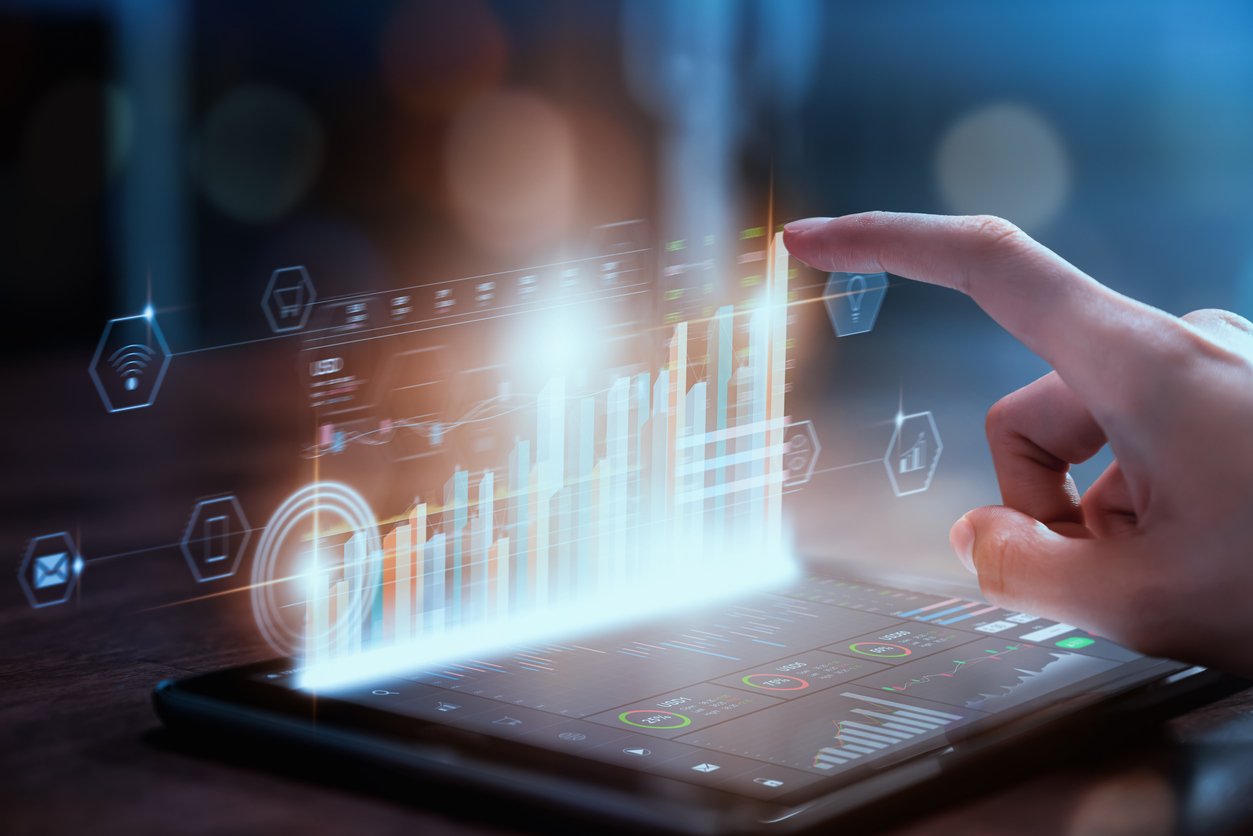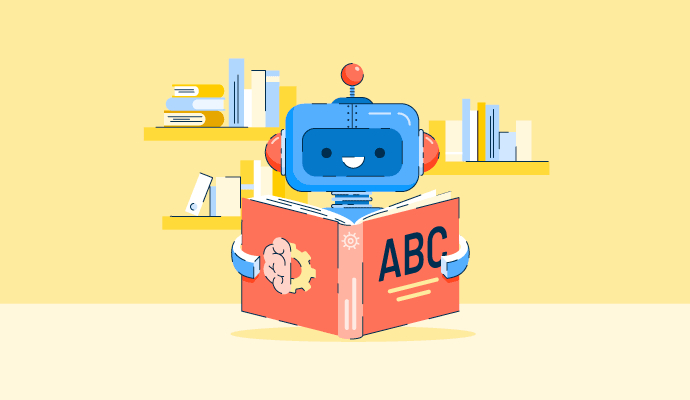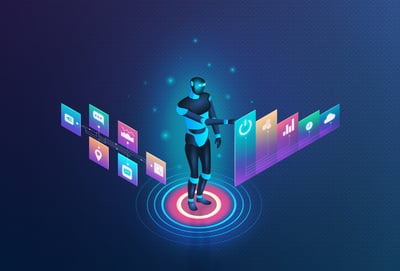

2023 is the year of artificial intelligence (AI). There’s no doubt about it.
But what else is trending in 2023? What are the top companies investing in? How are consumer demands changing? And what does that mean for software development?
If you're searching for a no-fluff guide on the top software trends that matter this year, you’ve come to the right place. This article explains the top software trends for 2023 and how you can leverage them to help grow your business.
Just like 2021 was the year of cryptocurrency, 2023 is the year of AI.
In other words, The only constant is change.
of AI buyers anticipate spending in 2024 will increase — 10 percentage points higher than overall.
Quantum computing is also rapidly developing, with some industries having the potential to gain up to $1.3 trillion in value by 2035 as a result.
Why do these advancements matter?
Plain and simple: By staying ahead of these trends, your organization can better implement strategic planning and decision making.
Recognizing the potential of these technologies can also open doors to new business opportunities, enhance your team’s skills, and help your business adapt to a rapidly changing digital environment.
With that said, let’s take a look at the most pivotal tech trends that are changing the future of life and business as we know it.
Continuing with the main event of the show — AI in all its glory.
Going forward, 81% of businesses agree that it’s important or very important that the software they purchase has AI functionality. And 84% trust or strongly trust the reliability and accuracy of AI-powered solutions.
From writing email drafts to outlining content briefs to creating unique images, generative AI is set to add $4.4 trillion in economic value. It also has a $5 billion equity investment as of 2022.
Source: McKinsey
Beyond ChatGPT, other examples of popular AI software include Jasper.ai and Google Bard.
SaaS platforms are also introducing AI features. For instance, Canva has a new text-to-image app for visual creatives. And monday.com just introduced an AI assistant to help third-party developers build project management apps on its marketplace.
However, ethical considerations and regulations are still at play.
As AI rapidly improves, investors and creators are considering how to keep people and businesses safe from malicious use or data leaks.
This year, legal’s role will become increasingly noticeable around the globe. Buyers and vendors will need to carefully consider how to treat their company’s data and the risks associated with generative AI output.
Virtual and augmented reality (VR and AR) are rapidly changing the user experience.
These technologies are transforming the way we interact with digital content.
A noteworthy development is a concept called “digital twin,” where a virtual replica of a physical object or environment is created, allowing users to deeply engage in realistic and interactive experiences.
For instance, in entertainment, VR opens new dimensions so users can step into virtual worlds and experience immersive adventures.
In real estate, professionals are leveraging AR to provide virtual property tours, helping potential buyers explore homes without ever leaving their couches.
Retailers are also applying AR to enhance the shopping experience, giving customers the option to try on virtual clothes or visualize furniture in their own space before making a purchase decision.
For example, Warby Parker, an eyewear retailer, offers an AR feature on its app so customers can virtually try on glasses to see how they look on their faces. Wayfair, an online furniture store, provides an AR feature that lets customers visualize furniture in their homes before making a purchase.
These examples enhance user experiences and reduce unnecessary friction, making the decision-making and buying process more seamless and enjoyable.
Cloud computing has been revolutionizing the way organizations handle their data and workflows.
Its innovation and widespread adoption have provided businesses with flexibility, cost savings, and enhanced collaboration.
Various cloud models are available, including public, private, and hybrid clouds, each offering distinct advantages based on specific needs and requirements.
A major cloud computing impact is its role in facilitating remote work.
With cloud-based systems, employees and freelancers can access their files and applications from anywhere, enhancing collaboration and productivity.
For example, workflow management software is a specific type of cloud computing that’s transforming business operations. By automating and optimizing key business processes, workflow management software can help users streamline tasks, minimize errors, and improve productivity.
Source: Pipefy
Workflow management software also provides a centralized platform for teams to coordinate and track their activities, promoting efficient project management. It also helps businesses simplify complex processes and reduce time-consuming manual tasks.
What’s more, cloud services are scalable, eliminating the need for costly hardware upgrades.
But even with its heap of benefits, businesses are still concerned about data privacy and security, especially with public clouds where data is stored on shared servers.
With this in mind, organizations must carefully consider their data handling practices and use thorough security measures to protect sensitive information.
IoT is completely changing the way we interact with the world around us.
With the development of IoT devices and advanced solutions like 5G, we're witnessing unprecedented connectivity and integration.
IoT is wedging its way into endless environments from smart homes to cities to industrial automation. For example, the city of Chattanooga is building a smart intersection network that uses IoT devices to enhance traffic flow and improve safety.
Still, businesses need to consider security and privacy challenges to ensure their IoT systems operate safely and securely. As technology develops, finding the balance between connectivity and safeguarding sensitive data will be key to fully harnessing the potential of IoT.
As we've touched on, safeguarding businesses against cyber threats has become more crucial than ever.
Small businesses, in particular, are vulnerable to financial and reputational damage caused by data breaches.
Even worse, the average cost of a data breach continues to rise, making it essential to have robust protection measures in place. As of 2022, the average cost of a data breach was $9.44 million. That’s up by four million dollars in less than a decade.
Source: Statista
The good news is there are tools and strategies available to counteract these threats.
From advanced endpoint protection and encryption technologies to employee training and security awareness programs, businesses can adopt a multi-layered approach to fortify their defenses.
Looking toward the future, compliance and regulatory aspects are also gaining prominence.
For example, some organizations use JWT tokens for authentication and authorization. JWTs help microservices authenticate and authorize each other without relying on a centralized server or database. They also allow for fine-grained access control and service interaction auditing, protecting businesses in the face of evolving cyber threats.
Blockchain technology is changing the way we manage data and supply chains — and we don’t just mean its association with cryptocurrency.
At its core, the blockchain is a decentralized and immutable digital ledger that records transactions securely and transparently. It eliminates the need for intermediaries, such as banks or third-party vendors, providing a direct and efficient peer-to-peer network.
One of its most prominent use cases is in supply chain management. By leveraging blockchain, supply chains achieve increased transparency, traceability, and accountability.
Each transaction or event is recorded on the blockchain, creating an audit trail that all participants can verify. This promotes authenticity and reduces the risk of fraud or counterfeiting.
Similarly, blockchain is also disrupting the finance industry, fostering faster and more secure cross-border transactions.
In the healthcare sector, blockchain improves patient data privacy and interoperability. Healthcare providers can share medical records with each other seamlessly and securely.
But while blockchain presents several benefits, it also faces challenges such as scalability, energy consumption, and regulatory frameworks. Thankfully, ongoing research and development are addressing these issues to unlock their full potential.
In the future, we can expect to see blockchain playing a pivotal role in various industries, transforming the way we store, manage, and trust data. In the end, harnessing the power of blockchain will lead to greater efficiency, transparency, and security overall.
Data processing strategies are also rapidly transforming.
Enter edge computing.
Instead of relying on a centralized cloud infrastructure, edge computing places computing resources directly at the edge of the network, closer to where data is created and needed.
By processing data locally, edge computing promotes real-time decision making and supports applications that require immediate and low-latency responses.
Latency is often measured in milliseconds and determines how fast and responsive communication between devices or systems is. Lower latency means faster transmission and reduced waiting time, while higher latency can result in delays and slower performance.
These benefits apply to several industries.
For example, in the realm of IoT, edge computing plays a vital role in managing and analyzing large data sets generated by interconnected devices. It also allows for quicker responses and reduces network congestion.
In autonomous vehicles, edge computing promotes real-time decision-making for navigation, object recognition, and collision avoidance. It’s also instrumental in real-time analytics, helping businesses process and analyze large amounts of data to improve marketing strategies and achieve operational excellence.
When comparing edge computing to traditional cloud computing, the key difference lies in the location of data processing.
Rather than depending on centralized data centers, edge computing moves computations closer to their source of data. This allows for faster response times and reduced reliance on a stable internet connection.
But edge computing isn't meant to replace cloud computing entirely.
While edge computing handles immediate local processing tasks, cloud computing provides the infrastructure for data storage, complex analytics, and long-term processing needs. In other words, the two can complement each other.
In the future, edge computing, cloud computing, and bioengineering innovations are expected to continue growing.
With over 400 identified edge computing use cases, and projections of double-digit growth globally in the next five years, these technologies are forever changing the way we handle data, compute tasks, and solve problems.
In 2023, even people without coding experience can create functional and customized software solutions.
Low-code platforms and tools simplify the process of building applications by providing visual interfaces and drag-and-drop features instead of using complex coding. This breaks down the barriers for people who may not have traditional coding skills but still want to create innovative apps.
But while low-code development platforms offer numerous benefits, future developers should still be aware of potential pitfalls.
The gist? Over-reliance on low code can limit a user's ability to learn and understand the fundamentals of coding.
In other words, to create truly innovative and complex apps, it's still essential to have a solid foundation in programming principles. Also, not all solutions can be effectively built using low-code tools, so being mindful of the limitations and scope of low-code is crucial.
Machine learning is an incredible technology that's been gaining momentum in recent years. It refers to the ability of computers to learn and improve from experience without being explicitly programmed.
This subfield of AI focuses on developing algorithms that can analyze and interpret vast amounts of data to make predictions and decisions.
From identifying market trends to forecasting demand, machine learning empowers organizations to stay ahead in a competitive market by leveraging data-driven decision-making.
Another important aspect of machine learning is its impact on creating a superior customer experience. Businesses can tailor their offerings to individual customers by analyzing user behavior and preferences. Machine learning algorithms can also analyze patterns and make predictions, so businesses can create ultra-strategic and targeted marketing plans.
Predictive analytics is another powerful application of machine learning. By analyzing historical data, machine learning models can identify trends that support businesses to make predictions about future behaviors and proactive decisions.
Other benefits include automation and increased efficiency. Machine learning algorithms free up valuable human resources by automating repetitive tasks and streamlining processes, so teams can focus on growth initiatives and creative endeavors instead.
Real-world applications of machine learning are vast and diverse. From healthcare to finance, marketing to security, the possibilities are endless.
For instance, machine learning used in:
Quantum computing represents a new frontier in computing technology.
This cutting-edge approach holds great promise for solving complex problems beyond classical computers' reach. With quantum mechanics, quantum computing creates powerful machines that can perform calculations at an unprecedented scale and speed.
In recent years, there have been significant advancements in this sector.
For example, Google made headlines with its quantum computer, which was 47 years faster than a supercomputer, in solving a specific problem.
Quantum technologies also saw a $2 billion investment in 2022.
Source: McKinsey
The potential applications of quantum computing are endless and can change countless industries.
By using quantum bits or "qubits", quantum computers can process vast amounts of data, and help businesses solve complex problems more efficiently and effectively than ever before.
Quantum computing also has the potential to impact consumer lives in ways we can't even imagine. From faster and more accurate drug discovery and development to improved logistics and supply chain optimization, its capabilities can transform how we live and work on a daily basis.
When it comes to industries likely to see the earliest economic impact from quantum computing, the automotive, chemicals, financial services, and life sciences sectors are at the forefront.
These industries stand to gain up to $1.3 trillion in value by 2035, thanks to the problem-solving abilities of quantum computers.
Source: McKinsey
By accelerating research and development, optimizing supply chains, improving risk assessment, and more, quantum computing can lead to significant advancements and economic growth in these fields.
Today we explored 10 software trends, including AI, edge computing, quantum computing, and more. These technologies hold immense potential, and recognizing their power can help you stay ahead in a rapidly changing digital landscape.
Investing in team skills and expertise in these domains can also provide a competitive edge and drive innovation.
It’s also important to remember that embracing these technologies isn't just about keeping up with trends. It's about seizing opportunities and intentionally shaping the future of your business.
Stay open to these advancements, explore their potential, and make the most of this digital revolution. By doing so, you can pave the way for new business ventures, enhance your team's capabilities, and build a thriving organization.
Trends in technology can rush by in a haze. In G2’s 2024 Technology Trends series, we decode the era of consolidation and automation and lay out the industry trends you need to know.

Automating business processes saves users’ time and energy, simplifying their jobs and allowing them to work more efficiently. Hop on to the AI bandwagon today.
Jeremy is the co-founder & CEO at uSERP, a digital PR and SEO agency. He also buys and builds SaaS companies like Wordable and writes for publications like Entrepreneur and Search Engine Journal.

Automating business processes saves users’ time and energy, simplifying their jobs and allowing them to work more efficiently. Hop on to the AI bandwagon today.
Remember the days of manually entering data into spreadsheets, cross-referencing paper files,...
 by Parvathy Nair
by Parvathy Nair
In 1993, the first documented virtual event happened — an online trade show organized by the...
 by Akanksha Kumari
by Akanksha Kumari
Remember the days of manually entering data into spreadsheets, cross-referencing paper files,...
 by Parvathy Nair
by Parvathy Nair
In 1993, the first documented virtual event happened — an online trade show organized by the...
 by Akanksha Kumari
by Akanksha Kumari
Never miss a post.
Subscribe to keep your fingers on the tech pulse.




